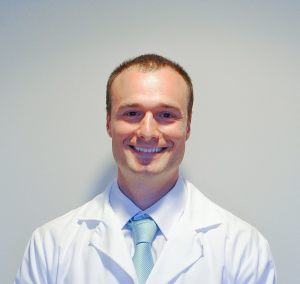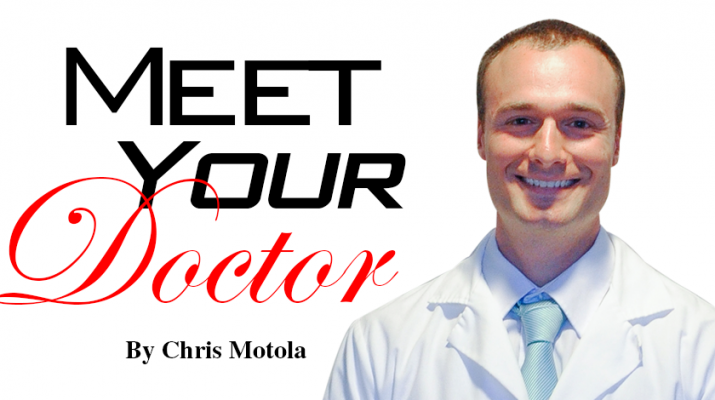Podiatrist developing new outpatient podiatry clinic at St. Ann’s Community
By Chris Motola
 Q: Can you describe podiatry’s niche in the broader medical picture and how it differs from M.D./D.O. practice?
Q: Can you describe podiatry’s niche in the broader medical picture and how it differs from M.D./D.O. practice?
A: We’re opening up a podiatry office that will be combined with the Wound Healing Center at St. Ann’s. It’s an outpatient facility serving Rochester and the surrounding counties. We treat foot issues, lower extremity down. It incorporates things from routine diabetic foot care to bunions and hammer toe surgery, to heel pain and plantar fasciitis. The wound center, of course, offers treatment for other traumas; other practitioners can take care of patients there. But basically as far as podiatry, we focus on anything from the ankle down. We have an X-ray machine on site to diagnose bone pathologies with the patient in the room. Anything from mild pain that can be treated with stretching or injections to surgeries, which are done over at Rochester General or outpatient surgery centers.
Q: Who are your typical patients?
A: Our demographics are pretty wide. I’ve treated 1-month-olds up through mid-90s. You can see a podiatrist at any age. People with diabetes will probably see us the most, referred by their primary care doctor for diabetic foot and nail care because they’re at a high risk for ulceration, especially older patients. But sports and pain issues, we’ll see a lot of patients in their teens, 20s, 30s and 40s. We can recommend and provide measurements for certain shoe gear and accessories.
Q: Are diabetic foot issues your most common complaint?
A: Because we’re associated with the Wound Healing Center, we see more of that type of patient. Maybe 60 percent is diabetic foot care and 40 percent is sports issues and general pain.
Q: Are the pain issues usually structural?
A: The most common complaint would probably either be heel pain or flat feet, which are often diagnosed. That’s when the arch is a little bit depressed. That can be helped with something as simple as using an insert to bump up the arch, which can help them walk longer distances, experience less pain. There are also a lot of pathologies that can develop from flat feet, things like bunion and hammer toes, tendon issues, strains.
Q: What causes flat feet and fallen arches? Are people just born that way, or do the problems develop?
A: It can be genetic for the most part. But also as we age, the tendons pull and weaken, especially with improper footwear. So the arch can collapse a little more from those factors. We can’t really fight the genetic component, but we can help it not get worse.
Q: What sort of accessories do you prescribe?
A: I usually start off with over-the-counter inserts to make things easier on the wallet. Those can range from $15 to $40. And then there are custom inserts that are molded in the office and sent down to the lab. They usually run a couple hundred dollars, so nothing too crazy.
Q: What will your role be in the clinic?
A: I’ll be the chief podiatrist, but as of right now it will only be me. I’ll be seeing patients for foot and ankle issues, and any ulcerations will be sent to the wound center.
Q: Will you be taking on additional podiatrists?
A: It’s definitely going to grow. We’ll meet the need as time goes on. But this is a good way to treat patients in the area, with Rochester General right across the street and our ability to work with the wound center. I think that will help us stand out from a typical podiatric practice.
Q: Does insurance usually cover podiatry?
A: We’ll be accepting all insurances shortly, everything from Medicare, to Medicaid, to Excellus, Aetna, etc.
Q: Normally would a patient be referred to you, or just walk in?
A: Walk-ins are accepted. Referrals mostly come from a primary care doctor, especially if the insurance requires a referral. But a lot of insurances these days will cover walk-ins.
Q: Philosophically, where do you see the podiatrist’s role relative to the medical industry?
A: I’ve been working with specialists out of Rochester General, everything from orthopedics, endocrinologists, general practitioners, as well as a lot of private practices in the local area.
Q: How did you become interested in podiatry?
A: I was actually in college and my sister was in podiatry school. I ended up shadowing her and really liked what I saw. I ended up going to school in New York City, graduating, and then wanting to move back up here to my home. I started my practice three years.
Lifelines
Name: John Ellie, DPM
Position: Chief podiatrist at St. Ann’s Community
Hometown: Greece, NY
Education: Pace University; New York College of Podiatric Medicine; SUNY Downstate Medical Center
Affiliations: St. Ann’s Community, Rochester General Hospital, Unity Hospital
Organizations: American Board of Podiatric Medicine; American Board of Podiatric Surgery
Family: N/A
Hobbies: Working out, tennis, running

